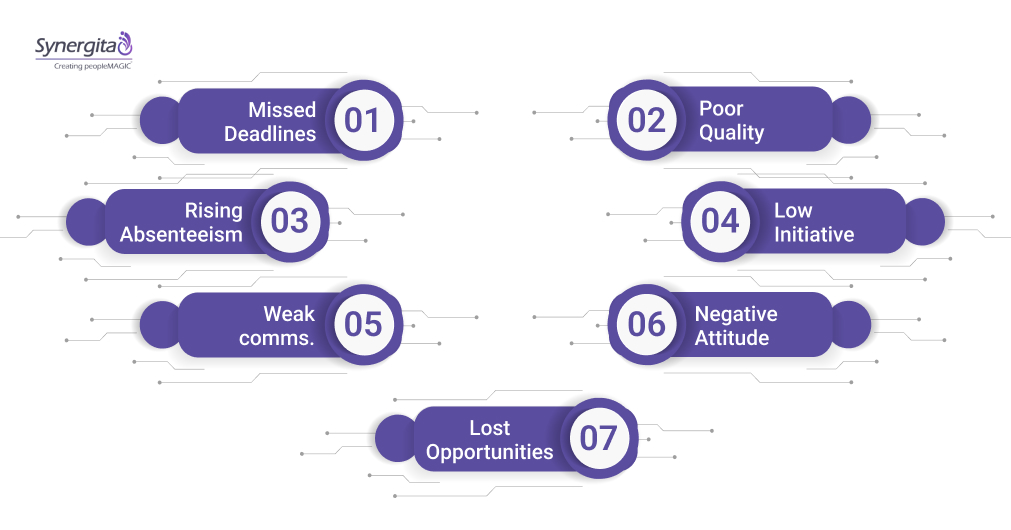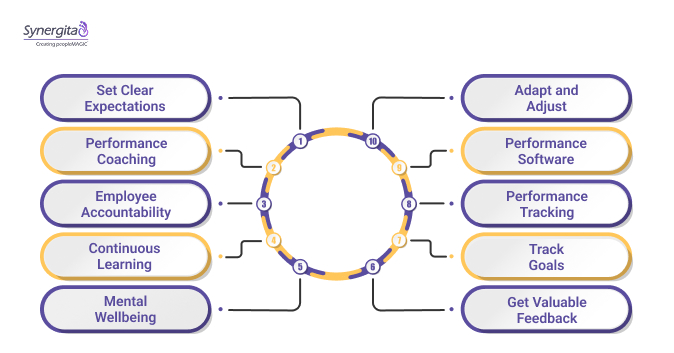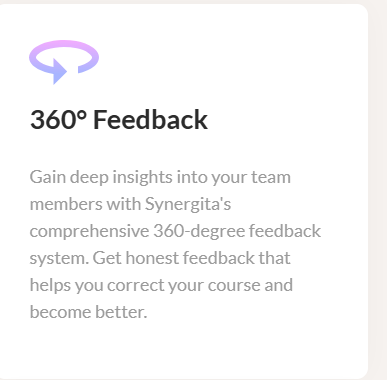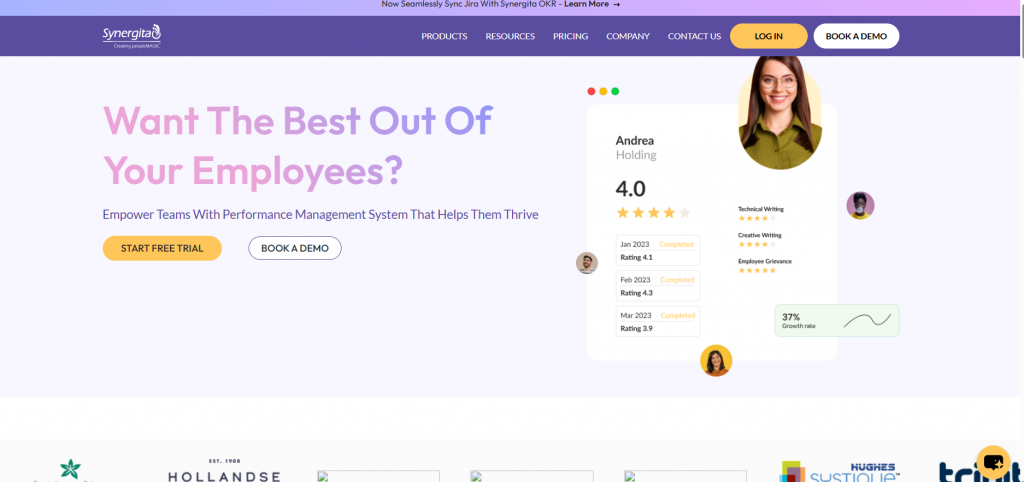Many businesses are facing productivity challenges with their employees, even when applying the best tactics. The reason they are failing constantly is that they are unable to understand the reason behind poor performance.
One of the reasons is that most of the team members are not engaged in their work in 2025. Global employee disengagement has dropped by 21% compared to its usual level. Lack of feedback, unclear goals, or ineffective systems, underperformance remains a hurdle that many teams just can’t seem to overcome.
You may have introduced goals, conducted reviews, or even tried different feedback methods. However, if you’re still experiencing poor performance, it’s time to take the right, actionable, practical steps.
This blog will show you how to manage employee performance to close that gap and choose strategies that successful HR managers are applying in real life.
In a Nutshell
- Clear expectations and regular feedback drive employee alignment with company goals, boosting productivity and engagement.
- Performance coaching helps employees improve, focusing on skill gaps and providing personalized development plans.
- Helping employees with autonomy and the right tools reduces micromanagement and increases ownership.
- Promote continuous learning by offering diverse development opportunities, ensuring your team remains competitive and motivated.
- Using performance management software organizes feedback, tracks goals in real-time, and ensures consistent performance monitoring.
What is Employee Performance Management?
If you’re an HR manager, team leader, or business decision-maker responsible for performance, you know the importance of team productivity. So, you choose performance management as the cornerstone for how your teams will perform and grow.
Employee performance management is the ongoing process that ensures individual efforts align with organizational objectives. It involves setting clear goals, providing regular feedback, and assessing progress to help employees meet both short-term and long-term targets.
Despite its significant benefits, only 2% of chief human resource officers think performance management is useful and can actually bring some results. The unreliability is real, knowing that even after applying the best strategies, expected results are not achieved.
In most cases, businesses don’t even need a better management system. What they need is better leadership.
So, before you change your mind about its efficiency, first, you need to understand whether your team even needs a new structure. In the next section, you’ll get a checklist to determine that.
How to Know Your Team’s Performance Is Off-Track?

You have communicated expectations, but something still feels off. It’s not always easy to pinpoint when things are slipping, but catching it early can make all the difference.
So, you need to know how to spot the red flags and course-correct before underperformance becomes a bigger issue. Here’s a checklist to understand if you need a better strategy or a better leader:
- Consistent Missed Deadlines: When employees regularly fail to meet deadlines, it’s a sign that they might be struggling with workload management or motivation.
- Declining Quality of Work: A noticeable drop in work quality, whether in attention to detail or consistency, may signal that employees lack the necessary resources.
- Increased Absenteeism: Frequent lateness can indicate that employees are disengaged, stressed, or lacking motivation to show up and perform.
- Lack of Initiative: Employees who once showed proactive behavior but now only perform minimal tasks could be losing interest in their roles or lacking direction.
- Declining Communication: Communication breakdowns, whether with teammates or managers, can indicate frustration or a lack of clarity about expectations or job duties.
- Negative Attitude: A shift toward negativity, complaining, or even a lack of collaboration can quickly spread, affecting team dynamics and overall performance.
- Missed Opportunities for Growth: If employees aren’t taking advantage of growth opportunities, it could suggest they are no longer invested in progressing within the company.
If most of the issues are commonly occurring in your team, you immediately need an employee management system instead of hiring someone new. But how do you do that?
What steps will ensure your actions can actually bring results? Find those answers in the next section, as it’s packed with practical tips that can speed up the result.
How to Manage Employee Performance?

Without the right strategy, productivity can slip, and disengagement sets in. However, leaders who adopted the approaches below are continuing to see the growth. So, don’t let performance gaps slow you down, and here’s how to fix them, fast:
1. Set Clear Expectations
When employees understand what’s expected of them from the start, they can align their efforts with company goals. This foundational step ensures that everyone knows their roles, responsibilities, and performance standards. Without clear expectations, it becomes challenging to track progress, offer feedback, or measure success.
Actionable Tips:
- Create Detailed Job Descriptions: Ensure each role is clearly defined, outlining specific responsibilities and goals.
- Use OKRs for Clarity: Implement Objectives and Key Results (OKRs) to provide clear direction and measurable outcomes.
- Communicate Expectations Regularly: Ensure ongoing discussions about performance goals, not just during reviews.
- Involve Employees in Goal Setting: Encourage employees to set personal objectives that align with company targets.
2. Performance Coaching
Performance coaching is a personalized approach that targets skill gaps and helps employees improve. Coaching allows employees to build confidence and improve their abilities. It’s a vital tool for continuous improvement and helps employees progress in their roles while boosting their engagement.
Actionable Tips:
- Have Regular One-on-One Sessions: Schedule coaching sessions to address individual needs and development areas.
- Focus on Skill Development: Customize coaching on the specific skills that need improvement, whether it’s technical or soft skills.
- Use Constructive Feedback: Encourage a growth mindset by focusing on how to improve rather than only pointing out mistakes.
- Set Clear Action Plans: After coaching sessions, outline clear steps for improvement and goals to achieve.
If you’re struggling to implement any steps like 1:1 sessions, Synergita’s Engage platform will be the right choice for you. With features such as tracking goals and setting up continuous feedback workflows, it ensures that coaching occurs regularly.
3. Encourage Accountability Among Employees
When employees feel trusted, they are more likely to take initiative, solve problems independently, and contribute to the organization’s success. Accountability creates an environment where employees feel valued, resulting in higher productivity and satisfaction.
Actionable Tips:
- Delegate Meaningfully: Give employees control over projects that align with their skill sets and aspirations.
- Provide the Right Tools: Ensure they have the necessary resources, training, and support to succeed in their roles.
- Acknowledge Ownership: Recognize employees when they take ownership and initiative, reinforcing a sense of responsibility.
4. Promote a Culture of Continuous Learning
A culture of continuous learning is vital for any organization that wants to stay competitive. Provide opportunities for professional growth, and keep employees motivated and engaged. Training programs, workshops, and learning resources create a workforce that’s ready to meet challenges head-on.
Actionable Tips:
- Offer Diverse Learning Opportunities: Provide online courses, workshops, or mentorship programs to suit different learning styles.
- Make learning Accessible: Ensure that learning resources are easily accessible and that employees are encouraged to use them.
- Incorporate Learning Goals into Reviews: Make learning and development part of performance reviews to keep employees focused on growth.
- Encourage Peer Learning: Facilitate knowledge-sharing sessions where employees can teach and learn from each other.
Many leaders and HRs face challenges with career tracking and growth opportunities among employees to see clear paths for improvement. With Synergita’s performance management software, you can offer coaching, skill training, and track development goals alongside performance metrics.
5. Prioritize Mental Health and Well-being
A stressed or burned-out employee cannot perform at their best. When organizations prioritize employee wellness and health, employees bring their best selves to work.
Mental health initiatives help employees manage stress, improve focus, and maintain productivity, leading to a more resilient and efficient workforce.
Actionable Tips:
- Offer Flexible Work Arrangements: Allow employees to adjust their work hours or location to better manage personal and professional responsibilities.
- Provide Mental Health Resources: Make mental health services like counseling or wellness programs available to all employees.
- Promote a Balanced Workload: Prevent burnout by managing workloads and encouraging employees to take breaks and use their time off.
- Foster an Open Environment: Encourage employees to talk about their mental health openly without fear of stigma or judgment.
6. Get Valuable Feedback
Feedback is one of the most powerful tools for improving performance. When given regularly and constructively, feedback helps employees understand their strengths and areas for improvement.
Providing feedback shows you want to guide employees toward improvement and acknowledge their successes.
Actionable Tips:
- Be Timely with Feedback: Give feedback as soon as possible after an event or action so that it’s relevant and actionable.
- Focus on Constructive Criticism: Offer feedback that is clear, specific, and solutions-oriented, rather than just pointing out issues.
- Balance Positive and Negative Feedback: Use the “sandwich method”. It is a technique for delivering constructive feedback by “sandwiching” negative comments between positive ones. So, it makes the feedback easier to accept and less likely to trigger defensiveness.
- Encourage Self-Reflection: Ask employees to assess their own performance before providing feedback, which encourages self-awareness and growth.
Few leaders become proactive in feedback sessions, but later they fail to continue it at regular intervals. So, it results in incomplete guidance.
To solve that, Synergita’s Perform platform enables continuous feedback through customizable workflows.

With features like 360-degree feedback, managers can also gather insights from peers, subordinates, and supervisors to give feedback to employees.
7. Track Goals
Regular tracking ensures that goals are being met and that employees stay focused on what matters most to the organization. A well-managed goal-setting process helps to align individual efforts with the company’s broader objectives.
Actionable Tips:
- Break Down Large Goals into Smaller Tasks: Help employees manage large projects by dividing them into smaller, more achievable tasks.
- Check in Regularly: Have periodic check-ins to ensure progress is on track and provide guidance if necessary.
- Celebrate Goal Achievements: Acknowledge when employees reach milestones, reinforcing their commitment and motivation.
It’s not easy to ensure consistent manual tracking when your team is scheduled with other important tasks. However, with Synergita’s OKR Module, you can align, track, and measure individual and team goals in real-time.
Synergita’s integration with platforms like Jira and Microsoft Teams ensures continuous updates. On the other hand, its cascading OKRs allow teams to work toward organizational goals in alignment.
8. Measure Performance Regularly
Before you skip this section thinking, tracking goal is already enough, let’s stop you there. Tracking goals is more like measuring how far you reach in your goal.
On the other hand, performance tracking shows you how well you are aligned while walking towards the goal. That’s why it prevents issues from spiraling out of control and ensures that employees can improve their work.
Frequent performance assessments also allow managers to spot skill gaps and offer developmental support before problems escalate.
Actionable Tips:
- Use a Variety of Metrics: Track both qualitative and quantitative data to get a well-rounded view of performance.
- Analyze Behavioral Trends: Observe changes in employee behavior over time to identify potential performance issues or areas of growth.
- Facilitate Open Conversations: Create opportunities for employees to voice challenges, discuss goals, and align expectations, building transparency and trust.
9. Use the “Right” Performance Management Software

Emphasizing the ‘right” word is a signal to tell you that not every market-trending platform is right for your company. Your team needs a platform that removes manual tasks, offers real-time data, and makes it easy to provide timely feedback.
You also want most of the features to be cost-effectively. Fortunately, with automated workflows, Synergita’s performance management software allows managers to focus more on coaching rather than administrative work.
Actionable Tips:
- Use Analytics: Use real-time dashboard and analytics tools to assess team performance, trends, and areas of improvement.
- Customize for Your Needs: Choose software that fits your specific organizational needs, with customizable workflows, templates, and reporting tools.
- Track Long-Term Progress: Use performance management tools to monitor progress over time and ensure continuous development.
10. Adapt and Adjust:
As business needs change, so should your approach to managing employee performance. Adapting ensures that performance processes remain aligned with organizational goals.
Actionable Tips:
- Regularly Review Your Strategy: Set periodic reviews of your performance management system to ensure it aligns with evolving business needs.
- Monitor Industry Trends: Keep an eye on performance management best practices and adjust your strategies accordingly.
- Stay Flexible: Be willing to adjust goals and performance metrics if the business landscape changes or if teams face new challenges.
As you are now aware, performance management isn’t a generic process. It requires constant evaluation, adaptation, and the right tools to support both employees and managers. Are you ready to take your performance management to the next level?
Wrapping Up Your Employee Performance Management Strategy
Now that you have a solid understanding of how to manage employee performance, it’s time to implement these strategies. From now on, there will be no more lost revenues due to poor performance, so be prepared to watch your team thrive.
Don’t wait for performance gaps to widen; take control now and create a culture of continuous improvement.
Request a Demo today and see how Synergita drives your team’s success. Now is the right time to lead your organization toward its next big milestone!
FAQs
1. How do I handle an underperforming employee?
To manage underperformance effectively, first identify the root cause of the issue. Then start providing and offering support through coaching or performance improvement plans (PIPs).Consistent communication is key to resolving performance issues.
2. How can I track employee performance without micromanaging?
Instead of micromanaging, focus on regular check-ins and using performance management tools to monitor key metrics. Help employees by giving them autonomy while providing ongoing support and feedback to help them stay on track.
3. What’s the best way to give feedback to an underperforming employee?
When giving feedback, be specific and constructive. Focus on the behavior or actions rather than the person. Offer solutions and development plans to help the employee improve.Make sure the conversation is timely, private, and respectful to build a growth mindset.
4. How often should I conduct performance reviews?
Performance reviews should not be limited to once a year. Aim for quarterly or biannual reviews to ensure continuous feedback and goal adjustments.Regular check-ins allow you to catch issues early, track progress, and keep employees aligned with company objectives.


